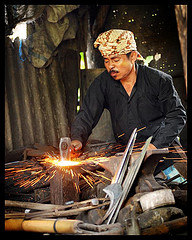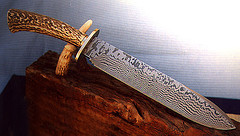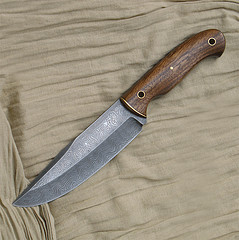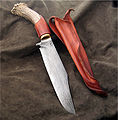"The
Process"

The
process has been around for
thousands of years and those
that are trying their best
to create an authentic item
for you, are replicating the
steel the best they can, the
way it was made in the past,
but doing so with a bit of
modern technology.
Iím not
going to hold it against
them and neither should you.
They are all artists in
their craft and genuinely
have a passion for what they
do.
We should
thank them for their time
and not ridicule then for
it. To start, the process of
producing a Damascus knife
is called pattern welding.
If you
donít have the drive to wax
your truck, you probably do
not want to take up
blacksmithing. It is a
tedious process but with
much reward.
Pattern
welding is taking multiple
layers of metal, folding
them together, and bonding
them by forge welding. What
this does, or what it should
do depending on your degree
of expertise, is give you a
nice blade that is both hard
and flexible.
 It
also gives you that awesome
Damascus steel look that we
all want to have in our
collection.
It
also gives you that awesome
Damascus steel look that we
all want to have in our
collection.
Getting
the exact carbon content in
the mixture for the steel is
a pain in the, you know
what. If you get too much
carbon, you got a pile of
cast iron on your hands and
if it is too little then you
have a pile of wrought iron.
Today a mixture of high
carbon steels are used for
the layers. Usually a basic
carbon steel like 1095 along
with a nickel bearing carbon
steel like 15N20. The nickel
in the steel resists the
acid etching giving the
blade the brighter layers
you see.
"Forging And Finishing"

Pattern
welding is like using
building blocks. Different
steels are stacked in a
pattern into a block or
billet, putting them
together and holding them
with a steel wire until the
first weld is in place. The
more intricate patterns are
often layers of damascus
that have been twisted or
deformed in some way, cut
and stacked in a manner that
when welded together gives a
very unique pattern to the
finished blade.
The pieces
are thinned out drastically,
and then removed from the
furnace where the blacksmith
folds the steel over and
over; most commonly you will
have over 500 layers when
the smith is done. The
folding and adding of the
layers are what makes the
steel strong. The whole
process is what causes the
steel to be as great as it
is. The process gives you a
sharper blade than that of
other common steels.
 Finally, after the blade of
the Damascus knives are
shaped, they are placed back
into the furnace until it
reaches a temperature of
1500 degrees. It is removed
and is quenched in oil. The
blade then needs to be
tempered so it is heated
back to 425 degrees for
about 2 hours. After it
cools, it is sanded with
fine sandpaper and
sharpened. The etching in
the blade is done by using a
mix of acid and water to eat
away the softer metal
revealing that Damascus
steel look and feel.
Finally, after the blade of
the Damascus knives are
shaped, they are placed back
into the furnace until it
reaches a temperature of
1500 degrees. It is removed
and is quenched in oil. The
blade then needs to be
tempered so it is heated
back to 425 degrees for
about 2 hours. After it
cools, it is sanded with
fine sandpaper and
sharpened. The etching in
the blade is done by using a
mix of acid and water to eat
away the softer metal
revealing that Damascus
steel look and feel.
You will
want to own one of these
steel items, if not for the
durability, then certainly
for the beauty and the
history. You will stare at
them for hours at a time.



 It
also gives you that awesome
Damascus steel look that we
all want to have in our
collection.
It
also gives you that awesome
Damascus steel look that we
all want to have in our
collection. 
 Finally, after the blade of
the Damascus knives are
shaped, they are placed back
into the furnace until it
reaches a temperature of
1500 degrees. It is removed
and is quenched in oil. The
blade then needs to be
tempered so it is heated
back to 425 degrees for
about 2 hours. After it
cools, it is sanded with
fine sandpaper and
sharpened. The etching in
the blade is done by using a
mix of acid and water to eat
away the softer metal
revealing that Damascus
steel look and feel.
Finally, after the blade of
the Damascus knives are
shaped, they are placed back
into the furnace until it
reaches a temperature of
1500 degrees. It is removed
and is quenched in oil. The
blade then needs to be
tempered so it is heated
back to 425 degrees for
about 2 hours. After it
cools, it is sanded with
fine sandpaper and
sharpened. The etching in
the blade is done by using a
mix of acid and water to eat
away the softer metal
revealing that Damascus
steel look and feel.